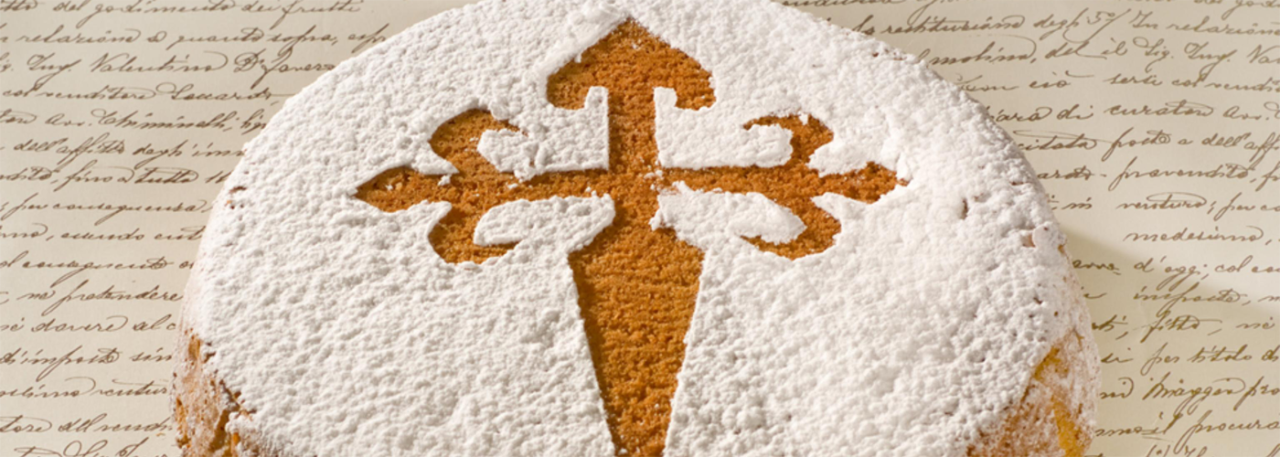.png.transform/rendition-xs/image_image%20(1).png)
Tarta de Santiago PGI
Traditional Galician sweet tart made using the basic ingredients of almonds, sugar and egg.
Tasting notes
It has a typical aroma of egg yolk and almonds, with the latter giving it a distinctive flavor. It has a spongy and granular texture.
Other notes
It has a rounded shape with a coating of icing sugar and the Cross of the Order of Santiago marked on the top. The icing sugar decoration gives it a white upper surface. When cut, it is a golden color inside.
Production / Processing method
a) Ingredients of the tart without pastry base, or of the filling in the case of tarts with a base:
- Premium quality almonds > 33% of total dough weight
- Refined sugar (sucrose) > 33% of total dough weight
- Egg > 25% of total dough weight
- Grated lemon zest (optional)
- Sweet wine, brandy, Orujo liquor (optional)
- Icing sugar
b) If the tart has a pastry base, all bases account for a maximum of 25% of the total weight of the tart plus base and can be made using two formats and compositions:
- Puff pastry base made from wheat flour.
- Shortcrust pastry made from wheat flour, butter, refined sugar (sucrose), whole egg, milk and salt.
The production process consists of various stages, depending on how the product is to be presented. For the Tarta de Santiago without pastry base, the stages are as follows:
a) Selecting the almonds: when the almonds are received in the production centers, their quality is checked thoroughly. Only premium quality, clean, healthy almonds can be used, containing no foreign bodies and with a fat content of over 50% measured on the almond plus skin. The varieties used are normally Mediterranean.
b) Grinding the almonds: once the almonds have been selected and peeled if applicable, they are ground into a fine flour.
c) Weighing and mixing: once the almonds have been ground, they are weighed. They are then mixed with sugar and the eggs are added gradually, beating vigorously until a smooth-textured dough is obtained. This is when grated lemon zest and/or sweet wine, brandy or Orujo liquor can be added.
d) Filling: the dough is placed in round molds of different sizes, depending on the format being produced.
e) Baking: the molds are placed in an oven that has been pre-heated to a temperature of about 180º to 200ºC (356º-392ºF).
f) Cooking: when all the molds have been placed in the oven, it is closed and cooking time is around 30 minutes, depending on the thickness of the product.
g) Cooling: after cooking and once the tarts have been removed from the oven, they are left to cool for a while before they can be handled and decorated.
h) Decoration: once the tarts are cool, they are decorated with the outline of the Cross of the Order of Santiago by sprinkling icing sugar over a template, using a sieve.
The tart with pastry base, the dough for the tart is made using the method described above, and a different technique is used to make the pastry dough for the base. The base can be either puff pastry or shortcrust pastry. The steps for making the tart with pastry base are as follows:
a) The ingredients listed above are mixed for about 15 minutes until a homogenous dough is obtained. The dough is then placed on a table and cut with a roller or other suitable tool, before lining the molds.
b) When the molds have been lined with the pastry, the filling is added and the tarts are placed in the oven for baking, before being cooled and decorated following the steps outlined in the method for tarts without pastry base. In this case, however, the baking time is 45 minutes (depending on thickness) to allow both layers to cook through. The last step, as for the tarts without pastry base, is packaging and labeling.
Regulatory Council
Instituto Galego da Calidade Alimentaria (INGACAL)
Pazo de Quián - Sergude
15881 Boqueixon (A Coruña)
Galicia
Tel: (+34) 981 997 276
ingacal@xunta.es
www.medioruralemar.xunta.es/
www.tartadesantiago.org
Sources:
- Spanish Ministry of Agriculture
The Cross of the Order of Santiago is always marked on the top.


- Tarta de Santiago 1
- Tarta de Santiago 2

Galicia
